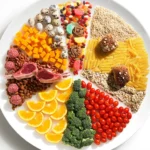Meal prepping is the strategic practice of planning, preparing, and portioning meals in advance—typically for the week ahead. It saves time, reduces stress, improves nutrition, and supports your health goals.
If you’ve ever found yourself staring at the fridge after a long day with no energy to cook, meal prepping is the solution. This guide walks you through how to effectively meal prep for the entire week in just one day.
Benefits of Weekly Meal Prep
Before jumping into the “how,” it’s worth understanding why meal prepping is worth the effort:
| Benefit | Description |
|---|---|
| Time-saving | Cook once, eat multiple times. Reduces daily cooking and cleaning. |
| Cost-effective | Reduces impulse food purchases and minimizes food waste. |
| Healthier eating | Helps control ingredients, portion sizes, and nutritional content. |
| Reduces stress | Eliminates daily decision-making around meals. |
| Supports fitness goals | Keeps calories and macros consistent. |
Step-by-Step Guide to Weekly Meal Prep

Plan Your Menu
Start with a clear plan. Choose meals for breakfast, lunch, dinner, and snacks that are simple, store well, and can be made in bulk.
Tips:
- Stick with recipes that use overlapping ingredients.
- Balance proteins, carbs, and fats.
- Choose 2–3 breakfast options, 2–3 lunch/dinner entrees, and a few versatile snacks.
Example Weekly Menu:
| Meal | Monday–Friday |
|---|---|
| Breakfast | Overnight oats, veggie egg muffins |
| Lunch | Grilled chicken with quinoa and veggies, turkey chili |
| Dinner | Baked salmon with brown rice and broccoli, stir-fry with tofu |
| Snacks | Greek yogurt, nuts, hummus with carrots |
Create a Shopping List
After planning your menu, write a detailed shopping list organized by grocery section. Grouping by category helps streamline your trip.
Sample Grocery Categories:
- Produce: broccoli, carrots, bell peppers, onions, garlic
- Proteins: chicken breasts, salmon, tofu, eggs
- Grains: quinoa, brown rice, oats
- Dairy: Greek yogurt, shredded cheese
- Pantry: olive oil, spices, beans, canned tomatoes
Prep Ingredients First
Before you start cooking, prep all ingredients:
- Wash and chop vegetables
- Marinate proteins
- Cook grains like rice and quinoa
This approach, often called “mise en place,” boosts efficiency and helps prevent kitchen chaos.
Batch Cook Strategically
Cook meals that require similar cooking methods together:
- Roast vegetables and proteins in the oven
- Use a pressure cooker or slow cooker for soups and stews
- Sauté or stir-fry meals on the stovetop
Invest in tools like sheet pans, large pots, and slow cookers to maximize efficiency.
Portion and Store Meals
Once everything is cooked, divide meals into individual containers. Use BPA-free containers with compartments or glass containers with lids.
Label with:
- Name of the meal
- Date it was prepared
Storage Tips:
- Refrigerate meals for up to 4 days.
- Freeze meals for the second half of the week if needed.
| Storage Time Guidelines |
|---|
| Refrigerated meals: 3–4 days |
| Frozen meals: 2–3 months |
Reheat and Rotate
When it’s time to eat, simply reheat your meals. To avoid boredom, rotate flavors and textures during the week:
- Use sauces or dressings to change up flavors.
- Alternate meals between lunch and dinner.
Additional Meal Prep Tips

Choose Versatile Ingredients
Pick foods that can be used in multiple dishes:
- Quinoa works in salads, bowls, and breakfast dishes.
- Chicken can be used in wraps, salads, and stir-fries.
Keep It Simple
Don’t overcomplicate with too many recipes. Focus on 2–3 core meals that can be varied slightly.
Prioritize Nutrition
Each meal should include:
- A source of lean protein
- Complex carbs (e.g., brown rice, sweet potatoes)
- Healthy fats (e.g., olive oil, avocado)
- Plenty of vegetables
Use the Right Containers
Invest in a variety of sizes:
- Single-meal containers for main meals
- Small containers for snacks and dressings
- Freezer-safe options for long-term storage
Schedule Your Prep Day
Choose a consistent day each week to prep—typically Sunday. Block out 2–4 hours. Put on music or a podcast to make it enjoyable.
ALSO READ: How to Make Refreshing Iced Teas at Home?
Conclusion
Meal prepping for the week in one day is one of the smartest strategies for saving time, eating healthier, and reducing stress. With a clear plan, some prep time, and the right tools, anyone can build a sustainable meal prep habit. Stick to a simple system, be consistent, and you’ll find that your weekly routine becomes more manageable, predictable, and enjoyable.
Whether you’re a busy professional, a parent juggling multiple schedules, or someone working toward fitness goals, meal prep can give you the structure and convenience needed to stay on track. Start small, build your system, and let your kitchen work for you.
Frequently Asked Questions
Q: How long does weekly meal prep take?
Usually 2–4 hours depending on the number of meals and complexity of recipes.
Q: Do prepped meals lose nutrients?
Slightly over time, but the difference is minimal and better than skipping meals or eating ultra-processed alternatives.
Q: Can I freeze all my meals?
Yes, most meals can be frozen. Avoid freezing meals with high water content like salads or yogurt.







